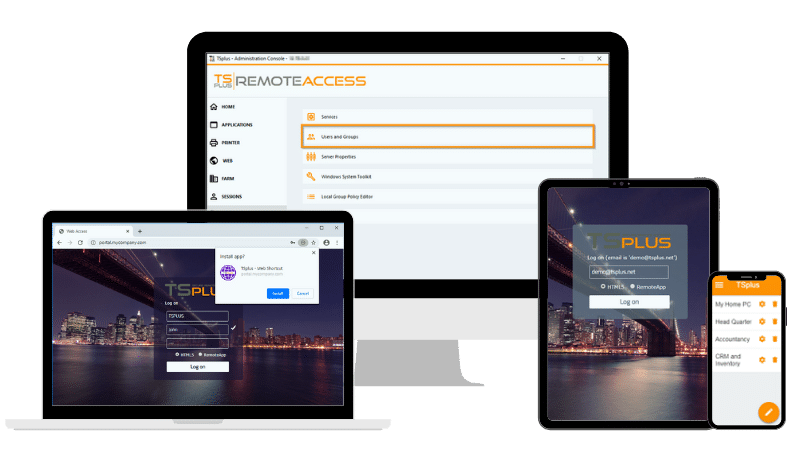)
)
What is Remote Desktop, and Why Enable It?
Remote Desktop is a built-in Windows feature that allows users to connect to and control a computer remotely from another device. This technology is invaluable for IT management, enabling administrators to troubleshoot issues without physically being in front of a device. For remote workers, Remote Desktop can offer a seamless connection to work computers from home.
Key Use Cases for Remote Desktop
· IT Troubleshooting: Allows IT staff to perform diagnostics, updates, and configurations remotely.
· Remote Work Access: Enables employees to connect to office computers from home, accessing files and applications securely.
· Server Management: Essential for administrators managing remote servers, as it offers direct control over the server’s interface.
Enabling Remote Desktop opens up these capabilities, but it is crucial to do so securely. Improper setup can leave systems vulnerable to unauthorized access.
How to Turn On Remote Desktop in Windows
To turn on Remote Desktop in Windows, follow these steps to ensure a smooth setup with the necessary security configurations.
Step 1: Access the Settings Menu
1. Open Settings: Click on the Start menu, select Settings, and go to System.
2. Navigate to Remote Desktop: In the left pane, scroll down to find Remote Desktop.
3. Open Remote Desktop Settings: This is where to configure and enable Remote Desktop access.
Step 2: Enable Remote Desktop
1. Toggle the Switch: In the Remote Desktop settings, turn on the Enable Remote Desktop toggle.
2. Configure Additional Options:
· Keep PC Awake for Connections: Ensure that the target computer remains available for remote access by selecting the option to keep it awake for connections.
· Allow Connections Only with Network Level Authentication (NLA): Enable this for added security by allowing only authenticated users to initiate a connection. Network Level Authentication provides an extra layer of protection, ensuring that only verified users can access the machine.
Step 3: Configure User Permissions
1. Allow Specific Users: Under the Remote Desktop settings, click on Select Users that can remotely access this PC.
2. Add Authorized Users: Only authorized users should have access. Administrators have permission by default, but you can add additional users if necessary. Be mindful to add only trusted individuals to prevent unauthorized access.
Step 4: Adjust Firewall and Network Settings
1. Firewall Configuration: For Remote Desktop to work, the Windows Firewall must allow connections over TCP port 3389, which Remote Desktop uses by default. Go to Control Panel > System and Security > Windows Defender Firewall > Allow an app or feature through Windows Defender Firewall. Ensure Remote Desktop is checked in both private and public networks.
2. Router Configuration for External Access: If you need to access the computer from outside your network, you may need to configure port forwarding on your router to forward port 3389 to the target machine. However, for more secure external access, it’s recommended to use a VPN rather than exposing the port to the internet.
With Remote Desktop now enabled, you’re ready to connect remotely. However, it’s essential to secure your setup to prevent unauthorized access.
Quick Setup, Ease-of-Use and Peace of Mind with TSplus Remote Access
For a more than affordable bill, TSplus meets those challenges and enables you to turn on remote desktops in all security. Paired with how easy the tool is to apprehend, its straightforward implementation marks our application and desktop publication software from our peer's. T

TSplus Remote Access Free Trial
Ultimate Citrix/RDS alternative for desktop/app access. Secure, cost-effective, on-premises/cloud
Security Best Practices for Remote Desktop
Enabling Remote Desktop brings significant benefits, but securing your setup is crucial to prevent unauthorized access. Below are best practices to ensure your remote access environment is both accessible and protected.
Enforce Network Level Authentication (NLA)
Network Level Authentication (NLA) is an added layer of security that requires users to authenticate before a remote session begins. By enforcing NLA, you significantly reduce the risk of unauthorized access.
How to Enable NLA:
· In the Remote Desktop settings, select Allow connections only from computers running Remote Desktop with Network Level Authentication.
· This will prompt users to enter their credentials before accessing the desktop interface.
Use Strong Passwords and Two-Factor Authentication (2FA)
Strong Passwords:
· Ensure that all user accounts with remote access have strong passwords. Passwords should be at least 12 characters long and include a combination of uppercase, lowercase, numbers, and symbols.
Two-Factor Authentication:
· For additional security, consider a two-factor authentication (2FA) solution. Some third-party tools, such as TSplus Advanced Security, support 2FA for Remote Desktop access, providing an additional layer of protection.
Access Remote Desktop Over a VPN
Using a Virtual Private Network (VPN) to access Remote Desktop can offer a secure, encrypted connection, preventing potential attackers from intercepting RDP traffic. A VPN tunnels the remote session through an encrypted network, masking it from public access. Remember, when using a VPN, that its security is only as strong as its credentials and access points.
Regular Software Updates and Patching
Keeping your operating system and Remote Desktop services updated is crucial for preventing vulnerabilities. Microsoft regularly releases security patches that address known issues in Windows and Remote Desktop. This need for regular Microsoft-related patching is amongst the main reasons for the existence of our Support and Updates subscription.
Enable Automatic Updates:
· To ensure timely updates, go to Settings > Update & Security > Windows Update and enable automatic updates. This helps keep your system protected against newly discovered vulnerabilities.
Implementing these best practices will help secure your Remote Desktop setup, minimizing the risk of unauthorized access while maximizing functionality.
Common Issues When Turning On Remote Desktop and Troubleshooting Solutions
When configuring Remote Desktop, you may encounter issues due to network restrictions or permissions. Here’s how to troubleshoot common problems.
Network and Firewall Blocking Issues
1. Check Network Configuration: Ensure that both the local and remote networks allow Remote Desktop connections. Confirm that port 3389 is not blocked by any firewalls.
2. Firewall Rules: Verify that the firewall on the remote computer is configured to allow Remote Desktop connections. Go to Windows Defender Firewall and make sure Remote Desktop is checked for both private and public networks.
User Permission Errors
1. Account Permissions: If users encounter permission errors, verify that they have been added to the list of allowed users under Select Users that can remotely access this PC in the Remote Desktop settings.
2. Administrator Access: Only administrators or designated users can access Remote Desktop. If needed, adjust user roles and permissions to grant the correct access.
VPN and Connectivity Problems
1. VPN Configuration: For users connecting via VPN, ensure the VPN connection is active and configured correctly. Some VPNs may require special configurations to allow RDP traffic.
2. Network Compatibility: If the VPN connection is slow, test different VPN servers or settings to optimize connectivity for a smoother Remote Desktop experience.
Why not find out how TSplus and others compare in this field of securing network traffic.
Enhance Your Remote Desktop Experience with TSplus Remote Access
For IT professionals and businesses seeking a secure, scalable solution beyond Microsoft’s built-in Remote Desktop, TSplus Remote Access offers an innovative platform tailored to meet the demands of remote work and IT management. Our software provides several enhanced features that make remote sessions more accessible, secure and manageable:
Why Choose TSplus Remote Access to Remotely Access Desktops?
· Multi-User Access: Unlike traditional RDP, TSplus Remote Access enables multiple users to connect to the same server or system, making it ideal for collaborative environments.
· Enhanced Security: With features like Advanced Security and two-factor authentication (2FA), TSplus ensures that your remote access remains secure, even in high-stakes IT environments.
· Cross-Platform Compatibility: TSplus Remote Access supports connections from various operating systems, making it easier for IT teams to manage diverse environments and user requirements. You can pick from different connection modes including HTML5, for complete freedom. Plus, you can adapt these to users and groups.
· Centralized Management: TSplus offers a centralized management console, making it easy for administrators to control sessions, monitor activity, and enforce security policies across the network.
By implementing TSplus Remote Access, businesses can ensure reliable, secure, and user-friendly remote desktop access for their teams. Learn more about TSplus Remote Access and explore how it can enhance your IT infrastructure for seamless and secure remote access.
To Conclude on How to Turn On Remote Desktop
With the above steps and best practices, your organization can enable Remote Desktop securely and efficiently. And for those needing a more comprehensive, multi-user solution, TSplus Remote Access offers a secure, scalable alternative, empowering IT professionals to manage and support remote connections seamless.














)
)
)